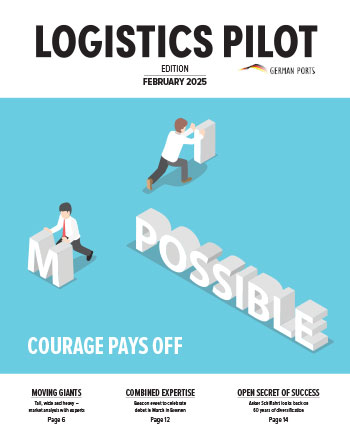Ferries are set to operate regularly between Wilhelmshaven and Norway – thanks to deep-freeze logistics company Nordfrost, which aims to use their own port site, including RoRo facilities, and to charter shipping.
of 100 to 130 vehicle units will connect Wilhelmshaven to Norway several times a week.
Photos: Pexels/Pixabay, Nordfrost;
Sketch: Heike May; Graphic: Nordfrost
Chartering of 150-meter ferry planned
There are also plans for a ferry connection to expand the company’s portfolio: “With forty logistics centres in Germany and Europe-wide deep-freeze transports, we have a broad base in our core business, on which we are developing port logistics as a new strategic business,” says managing director Britta Bartels. “My brother and I are convinced of our father’s idea and want to implement it in his spirit.”
A four-member project team is currently sounding out the market for suitable ferries. “We are doing market analysis and making contacts with potential business partners,” says Jan Sprock, who has been working for the deep-freeze logistics company as operations manager of ferry services since last autumn. Some things have not yet been decided. However, a few details have been settled. A ship is to be chartered rather than purchased outright. Sprock is currently taking over a 150 metre long freight ferry with a capacity of 100 to 130 vehicle units and up to twelve cabins.
The market has been analysed to determine the most suitable ports in Norway and appropriate departure frequency. “One port of call will probably be in southern Norway, but there may also be two weekly departures on the western coast,” says Sprock. Another option is a triangular connection with integration of the eastern coast. Currently, about two to three departures per week are planned, depending on the number of ports. “We assume that the ferry connection will generate users almost by itself. Nevertheless, we want to find ports in Norway with which we can meet the greatest possible demand,” says managing director Bartels. “To this end, our project team in Norway has looked around and promoted our plans.”
Facts
Established: 1975
Head office and European base: Schortens
Ranking: Germany’s leading service provider in deep-freeze logistics, market leader in Europe for deep-freeze capacities and among the top ten in deep-freeze warehouse logistics worldwide
Logistics centres: 40 in Germany
Deep-freeze pallet spaces: 810,000
Sales: approx. 430 million Euro 2019
Employees: approx. 3,000

Routes shortened by up to 800km
But there are also other reasons why Nordfrost assumes that the new ferry connection will be well received. A large part of the freight for the Western European market is currently transported from Western Norway via Denmark or Sweden. “The ferry connection will save up to 800 kilometres of road, depending on the destination, and of course CO2,” says Sprock. Such a connection would also be in line with the European Commission’s concept of introducing ‘maritime motorways’. As part of intermodal transport chains, these transnational maritime links are highly frequented and handle large transport volumes, just like conventional motorways. “And combined transport is also conceivable for us,” says Sprock. In future, the company’s own rail connection, which currently serves the Nordfrost seaport terminal in the Wilhelmshaven container port, could be used for this purpose. In the medium term, Wilhelmshaven could even become a point on the new Silk Road, says Sprock. “From China the goods can then be transported by rail directly to Wilhelmshaven and from there by ship to Norway.” In addition to the ecological advantages, he adds, there are also time savings. “With the ferry, transport is up to six hours faster than the next best alternative,” Sprock points out.
Logistics Pilot
The current print edition - request it now free of charge.
As far as the local conditions in Wilhelmshaven are concerned, even though the RoRo ramp is already in place, there are still a few things to do before the ships can dock at the 470-metre quay. Previously unpaved areas have to be paved and a new gate control system implemented. According to Sprock, the goal is already within sight. “Around the middle of the second half of the year we will have created the conditions for the start of the ferry service.“ (cb)







